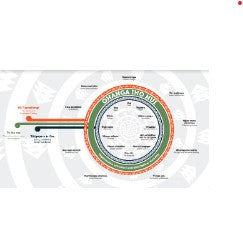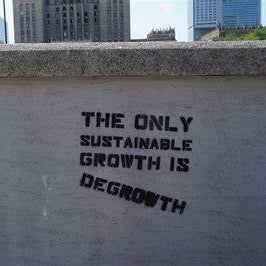12 years, just over 11 really, given the Intergovernmental Panel Climate Change (IPCC) report was issued in October 2018[1]. That’s how long we have before our global governments must implement a raft of legislation that will make our planet move to a more sustainable future. Sayings like “there are plenty of fish left in the sea,” “she’ll be right,” “the world’s your oyster,” are all coming undone. The chickens have come home to roost.
I recently went to see Kate Raworth at the NZ Writers Festival where she discussed her recently published book Doughnut Economics. The book outlines a new order of economics whereby humans must live between two circular boundaries. One boundary within what our earth can provide, and the other of the basic needs on which humans can live comfortably. Within those realms, we must learn to live. The economic theories of supply and demand are inherently flawed because they do not consider our limited Earth’s resources which we are currently plundering.

Most governments measure GDP, or gross domestic product as a means of success. Which is a fancy way of saying all the stuff produced and having more than last year is better. There have been several economists that reasonably argue that we need a new way to measure our economy. Jacinda’s wellbeing budget is the first that measures success in how we feel about ourselves, each other, the country and the world. This shows that the next generation of leaders can see that we need more than GDP to measure success.
The doughnut economic model requires a deep shift in thinking away from the constant requirement of GDP growth and development that all nations automatically work towards over-consumerism. We need a new green economy that prioritises products made from regenerative manufacturing, created with renewable energy, energy efficiency, excellent public transport, clean technology and water.
It’s an alternative vision to neo-liberal economics which produced the 2008 crash and continues to contribute towards massive income inequality, mass consumption, a looming crash and the downfall of our planet.
But for every problem, there is an answer. The solution that The ReCreators is on board to solve is that of over-consumerism. In the last 50 years, we have been driven to a never-ending pattern of purchasing which we have been sold as the best way to be. But don’t believe the hype. Products used to be made to last, and they can be again. In fact, they used to be built so well, that some of those actual products can be made again. This is one of the ways in which The ReCreators will stand in the way of our demise.
The business model for The ReCreators is three-fold. Firstly, we want to reach and teach everyone in our community the skills they require to upcycle their own wares themselves. This is our favoured option and more fun for everyone, not to mention the creativity and mental well-being from an upcycled hobby. Plus it’s going to be really handy if there’s a zombie apocalypse (or any apocalypse to be fair).

The second prong is to offer our ReCreators services to upcycle a customer’s personal wares back to new, which is great news for those who are sentimental, can’t bear to part with something you love, or want to pass on treasures to someone you love.
The third offering is a variety of upcycled wares that can be purchased online. For those that want new stuff, but you know, don’t want to hurt the planet.
The above model, if it were implemented in every town and city could provide sustainable products, local jobs and make people more creative and happier. If this model were replicated everywhere across the world, we’d have a solution to over-consumerism.
Let’s have a look at what Upcycling Economics looks like from various economic viewpoints.
The Household
So, this is the easiest place to begin. You need a new table, a piece of furniture, cushion, piece of jewellery or household decoration? Come along to one of our upcycling classes and learn the skills of repainting, uptangling (I know, it sounds like a mysterious martial art or philosophy, but really it’s just reparative patterns which are very meditative), power tools or sewing. We want to extend our classes to re-upholstery, jewellery making and furniture refurbishment in the future.
Pretty much anything in your house can be made new again. Repurposing is creative, insightful and you will end up loving that piece way more than anything you have bought in a department store because you have put your soul into it.
By spending less, you can save the household more, perhaps converting this to spending more time at home and less time working. Personally, I have given up a well-paid job to pursue this enviro-social enterprise and unsurprisingly, after working harder on this, I have also automatically spent less.
Being super-conscious of leading by example has been amazingly good for our household budget especially when we are down a salary. I can attest that this area works.

The Community
Maker Spaces are the future, along with the development of a circular economy and regenerative design. This is where a community can get together, create, invent, innovate and share. With people renting accommodation more than ever before, there are less and less people with access to garages, tools and places to make and create.
Maker Spaces provide both a place to work, learn and some super cool tools that can develop your skills more than anything you have at home. CNC machines, laser cutters, 3d printing– you make some cool shit there. You can also meet other makers, learn from their skills, see their work and attend workshops to develop new skills.
In New Zealand, there are maker spaces hosting mentoring programmes to help at-risk youth, provide opportunities for those re-entering society from prison or hosting social innovation enterprises.
So how do they work? You pay for a monthly/ annual membership where you come in and use the garage for personal projects. Government/ corporates can sponsor community activator programmes to improve social outcomes. The public can attend workshops to extend their maker skills. There would be options for innovators to use the space for prototype designs and inventions at affordable rates.
Maker spaces will need community crowdfunding, government and corporate funding/sponsorship to get these babies off the ground. These should become the norm and considered like a library in our daily lives. If we think books should be in our lives on a daily basis – so should maker skills.

The Business
Now, this is where the businesspeople will get antsy. If we are not buying new goods, then the economy will plummet. We need more stuff and make more money to buy more stuff – on and on it goes. The average Westerner owns 10,000 things. That’s outrageous – how have we gotten here. Because every marketer wants to remind you that you have a problem and they have the product to solve your problem. Marketing 101.
But I would like for you to look at it another way. If we instead, invested our technologies and skills in repurposing our manufacturing economies both at home and abroad (remember this would be a global vision), we would simply shift our focus on manufacturing new resources to upcycled/ recycled resources. H&M are investing in recycling clothing materials have released a new fashion line[2]. Imagine if every organisation did that!
Imagine an economy that was primarily based on reuse, repurposing – upcycling. All manufacturers would make things to last. If something broke down – they would be made to be fixed or stripped down with less than 20% new materials. For furniture, all companies would be based around reupholstering, rebuilding old furniture and making it new again. The jobs would remain, but they would just look different. This is not a new way, but a return to the old, which worked for all of the years before the 1950s.
It would be far more unusual to buy something new that something repurposed. To be fair repurposed items look new anyway and they cost the same. It’s just your expectation that everything is new that needs to be managed/ changed.
This is a game changer.

The Government
ALLgovernments need to get on board the new doughnut economic train. This will mean more regulation/ taxation around unsustainable practices but just to make some businesses happy, throw in some tax incentives/ investments/ funding for those doing good in making money or services.
Consumers need to stop buying crappy disposal items with short life spans and businesses need to be incentivised to produce quality, longer-life items that can be easily and affordably repaired. Governments also need to stop measuring our growth through never-ending GDP growth because the maths simply doesn’t add up and it doesn’t take a rocket scientist to see that. Having the NZ budget centred around well-being is a great start because it shows what government future planning is all about. The well-being of the planet and people.
Think about all the laws that most people (not all) obey without thinking too much about it – wearing seat belts, sending kids to school, traffic lights. We do so not because we chose to, but we were forced to via legislation. Regulations are there to ensure people’s safety. They also need to ensure our planet’s safety, which let’s face it leads to our safety. While many businesses see this as red tape – they are the same people that want an inquiry when a tragedy happens or want a bailout when the economy craps itself.
Conclusion
The ReCreators is an alternative to over-consumerism with positivity, creativity and a twist of mental well-being. A smooth cocktail that tastes great. It involves community makers working together to share their skills and help people upcycle their tired items at home. It allows these same makers to earn a decent living while having a meaningful job. Consumers divert their funds away from new items towards their own creative skills and maintaining a beautiful home. That saved income could, in turn, mean that they work less.
As consumers, we have performed “a drop in the bucket” of what needs to be done to keep our planet alive. While individual actions and activism help, we also need governments and corporates genuinely on board to create a circular, sustainable, doughnut economy.
Let’s turn things around. We can still have nice houses, but honestly, do we need 10 matching cushions on our beds?
[1] https://www.ipcc.ch/2018/10/08/summary-for-policymakers-of-ipcc-special-report-on-global-warming-of-1-5c-approved-by-governments/
[2] https://about.hm.com/en/media/news/general-news-2019/the-new-re-made-collection-from-weekday--turns-old-garments-into.html
Leave a comment (all fields required)
Comments will be approved before showing up.

